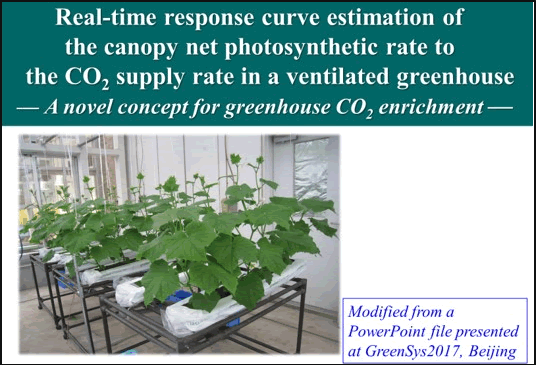We developed an light-emitting diode (LED)-artificial sunlight source system that can produce spectral irradiance distributions (SIDs) of the same level as full irradiation, within a wavelength range of 380-940 nm, of ground level sunlight (GLS) as well as SIDs modified arbitrarily by application of different voltages to LEDs and using 32 different peak wavelengths. The system can produce an irradiance of greater than 750 W m-2 for 380-940 nm at the light outlet with an area of 7.1 cm2 with a high approximation accuracy of produced SIDs to their target SIDs that we desire to produce. The system also has user-friendly graphical interfaces for producing the desired single (static) and time-varying (dynamic) light……

A greenhouse manager would supply CO2 to the greenhouse, even in a highly ventilated greenhouse, if it were certainly cost effective to supply CO2 at a certain rate. However, for a ventilated greenhouse, no useful index or criterion for the assessment of CO2 supply cost effectiveness. We propose a response curve of the canopy net photosynthetic rate (CNPR) to the CO2 supply rate (CSR) for a greenhouse on a cost-effectiveness assessment basis, with a novel procedure for real-time estimation of the response curve of CNPR to CSR in a ventilated greenhouse (CSR-CNPR curve). A greenhouse manager, based on a CSR-CNPR curve created with a short interval (a few minutes), can control the CSR to a greenhouse using a comp……

We focus on the production of recombinant proteins using plants as one of the effective applications of plant factories with artificial lighting (PFAL). A typical example is pharmaceutical proteins including vaccine antigens and monoclonal antibodies. Conventionally, these pharmaceutical proteins have been produced by culturing microorganisms or mammalian cells, or by culturing viruses using embryonated chicken eggs. However, the use of plants is thought to offer advantages such as lower production costs, higher scalability of production to meet demand, and reduced risk of pathogen contamination during the production process. We have conducted basic research to establish the environmental control strategy for P……

This project aims to analyze the effects of the light environment on photosynthesis from an ecophysiological point of view and to apply the findings to the control of the light environment in greenhouses and plant factories with artificial lighting. So far, we have been studying the effects of spectral distribution (light quality), supplemental lighting to lower leaves, and continuous (24-h) lighting. Currently, we are interested in the effect of fluctuating light environment. For these studies, we have utilized LEDs that can easily control spectral distribution and the time course of power output and can also irradiate locally. By using the knowledge and techniques of both biology and engineering, we aim to ac……